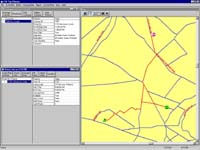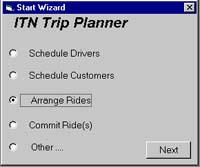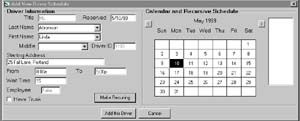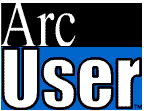|
In Portland, Maine, GIS is being used to make a small but important start in tackling what will be a growing problem in America—how to provide reliable, flexible, and economical transportation for seniors who should not drive but need mobility.

|
| The GIS-based application developed for ITN improves
efficiency without taking human judgement out of the process. |
Aging Drivers
By 2025 the U.S. Census Bureau estimates 18.5 percent of the population will be over 75 years old. As senior citizens increase as a percentage of the population, the number of older people driving increases. More elderly drivers and passengers die and are more likely to be severely injured in traffic accidents than younger adults. The number of traffic fatalities that older drivers will be involved in is expected to grow to rival the number of deaths caused by drunk driving.
Some states have reacted to current and expected increases in the number of accidents involving seniors by restricting licensing for older drivers. While this keeps them off the roads, it does nothing to solve the real transportation needs of this group. Many seniors live in suburbs and rural areas that lack the population density to support mass transit systems. In areas where mass transit is available, the inflexible schedules and limited destinations makes it a less attractive option. For some seniors, using mass transit is too physically demanding.
Depending on friends and relatives for rides limits the independence of seniors,
and many seniors feel that they have become a burden. This situation often causes seniors to pay for cars they feel less and less comfortable driving. Weather, time of day, and traffic conditions limit the times and places they can drive.
Providing incentives for private solutions is a viable approach given that Americans are accustomed to spending 19 percent of their income on transportation. By fashioning a system that answers the real need for mobility, seniors can be persuaded to use funds for a new transportation system instead of ineffectually spending money maintaining cars.
Step Away from the Car
The Independent Transportation Network (ITN) in Portland, Maine, provides an attractive replacement system for individual car ownership for seniors who choose not to drive and persons with visual handicaps.
|
The Independent Transportation Network provides an attractive
replacement system for individual car ownership. |
ITN, which began providing service in 1995, has developed a new transportation model geared to the needs of seniors who make up the majority of its customer base.
Within a 15-mile radius of the City of Portland, this on-demand service provides door-to-door taxicab-like transportation 24 hours a day, seven days a week at a very reasonable cost. ITN uses a combination of volunteer and paid drivers in ordinary passenger cars. Drivers escort seniors, buckle seatbelts, open doors, and carry packages.
Customers can choose between two types of serviceóby the mile and by the hour. With either type of service, no money changes hands in the vehicle. ITN customers are typically members of the organization and have prepaid transportation accounts. Members receive monthly statements that reflect debits for services used and estimate the next month's payment.
ITN members who schedule trips in advance or rideshare receive discounts. Currently 80 percent of the seniors using the program voluntarily schedule in advance and 79 percent have indicated they would be willing to rideshare. The system works to minimize cost by giving preference to volunteers over paid drivers, prints maps and instructions for drivers, and tracks miles. It promotes ridesharing by offering discounted rates for shared rides and by calculating the reduced rate.
A Community-Based Solution
ITN is a community-based, nonprofit solution. Economic sustainability is a top priority. In addition to encouraging seniors to spend money on transportation accounts rather than cars they can't or shouldn't drive, the system employs some innovative funding techniques that include merchant participation and payments from adult children.
ITN membership is open to interested members of the business and private communities as well as seniors and their families. A membership format was chosen so seniors feel a sense of ownership and belonging that would help replace the sense of loss some older people feel when they stop driving. Members receive a newsletter, birthday ride certificates, discounts for gift certificate purchases, and incentives for referrals.
The program began as a research project that was both publicly and privately funded. Initial funding came from the Federal Transit Administration (FTA), the Transportation Research Board (TRB), the American Association of Retired Persons (AARP), the National Highway Traffic Safety Administration (NHTSA), and the UNUM Foundation.
ITN is involved in two grant programs. It was given a three-year FTA Deployment grant to develop a system that would meet the mobility needs of seniors. The goals for the project include economic sustainability, use of intelligent transportation system (ITS) technology, and benefit to the rural elderly. This system should also be able to be implemented at other locations.
Harnessing GIS Technology
As part of the Deployment grant work, ITN is conducting research on using GIS for dispatch and ridesharing as well as innovative funding mechanisms for the program. This additional work is being funded through an IDEA Project Transit-19 grant from TRB. Esri and GeoFields, Inc., an Esri business partner, contributed to the creation of an application that uses GIS to improve routing, scheduling, and dispatch. The system harnesses technology to consumer demand rather than imposing requirements on consumers.
Tim Quinn and Yichang (James) Tsai worked on the project from the needs assessment phase through the testing phase. Tsai received a doctorate from Georgia Institute of Technology where he currently works as a research scientist at the GIS Center. Tim Quinn, who holds a master's degree in city planning and a bachelor's degree in geography, is the manager of transportation GIS at Geofields and has developed GIS transportation applications for local and state planning agencies.
Quinn and Tsai looked at how ITN was doing business.

|
| The application modules are accessed from the start wizard. |
They didn't want to replace a working system with a new one—they wanted to make the existing system easier to use and more efficient. At the time, ITN displayed driver information in Excel spreadsheets, kept the customer information in an Microsoft Access database, and looked at paper maps to do routing. The data model for ITN was already established.
The system they developed not only complements the existing practices, but it uses technology in a way that preserves the high level of customer satisfaction that existed using previous methods. "The design philosophy of this system is to streamline and facilitate human judgement instead of taking over the human decision," said Tsai.
When designing the procedure for optimizing a route, they could have opted to perform it in batch mode, but they wanted the dispatchers to be able to assign particular drivers to particular customers. "These people [drivers and clients] probably go to church together," said Quinn. "We had to build a human interaction function in to make it make sense. Optimization is tough enough, but we also wanted to keep human factors involved, which makes it pretty challenging."
The application, which does scheduling, dispatching, ride matching, and routing, was built using Visual Basic, MapObjects, and NetEngine and ties into an existing corporate database maintained in Access. It reads data from the corporate database and automatically writes the cost data calculated by the application back to the invoicing system.
"The technical issues we are facing here are not only to find the shortest path spatially, but also to consider the drivers' and customers' temporal constraints, to check the customers' requests and drivers' capacities and to achieve a cost-saving combination for the rideshare mathematically," said Tsai. Complex logistics problems such as the ones posed by ITN have been studied for years. Tsai enjoyed working on this project because, "with current technology, you are able to handle the problem and can implement the solution."
Designing for the Customer
The modules are accessed from start wizards that walk employees through the various modules in the application. Each module has a customized interface. Employees learned the five or six major system functions they needed fairly quickly. The driver scheduling module uses a calendar that Quinn and Tsai built from the ground up in Visual Basic. The dispatcher module displays maps.
|
"The elderly typically have trip patterns quite different from anybody else." |
By studying how customers used the system, they were able to realize efficiencies in interface design and operations. As Quinn observed, "The elderly typically have trip patterns quite different from anybody else." For the customer scheduling module, the system invokes a form employees fill out to schedule rides. The form's fields are already populated based on a default customer profile. The field entries can be changed, but seniors typically go to many of the same places over and over so this method saves time and effort.
One feature allows scheduling of recurring rides so that a customer, say Mrs. Smith, can make one call and be picked up every Tuesday morning for her doctor's appointment or bridge game until she cancels the ride. Another feature improves scheduling to common destinations. Many seniors go to some of the same destinations, such as shopping malls, but often don't remember the address. These "hot spots" or common destinations are listed as categories, such as malls or medical centers, with multiple locations. An employee scheduling a ride can choose from a list by the name of the destination.
Daily, weekly, and monthly views of a driver's schedule can be accessed from the driver module. |

|
Address matching allows dispatchers to manually assign addresses. This accommodates customers who live on rural roads without address ranges. The fact that many of ITN's customers live in town on established streets or in nursing homes limits the amount of manual address matching necessary.
Quinn and Tsai created mechanisms within the system to supply those services that were unique to seniors. ITN serves a social as well as a practical function for customers. The ride matching functionality illustrates this. Often a customer will call to schedule a ride to the mall or some other common destination. The customer wants to go the following week, but the exact time does not matter as long they can ride with someone. The GIS application searches for compatible dates and times and returns a list of candidates. The dispatcher can then assign a driver and customers based on knowledge of the customers.
Best Use of Technology
The program's success can be measured by the strong growth in rides and revenues. In the period between August 1997 and December 1998, the number of rides increased 122 percent from 663 to 1,475. Monthly revenues have mounted from $3,328 in 1997 to $7,244 in October 1998.
ITN identified the real need of seniors for mobility and uses technology, specifically GIS, to best answer that need. GIS simplifies the tasks of scheduling, routing, and dispatching rides and facilitates ridesharing. The system calculates fares for customers that are paying at various rates with nonstandard origins and destinations. It benefits seniors by supplying safe, responsive, economical transportation that improves their quality of life and makes roads safer while using existing infrastructure more effectively.
For more information on ITN, contact Tim Quinn at 404-875-2550.
| 


